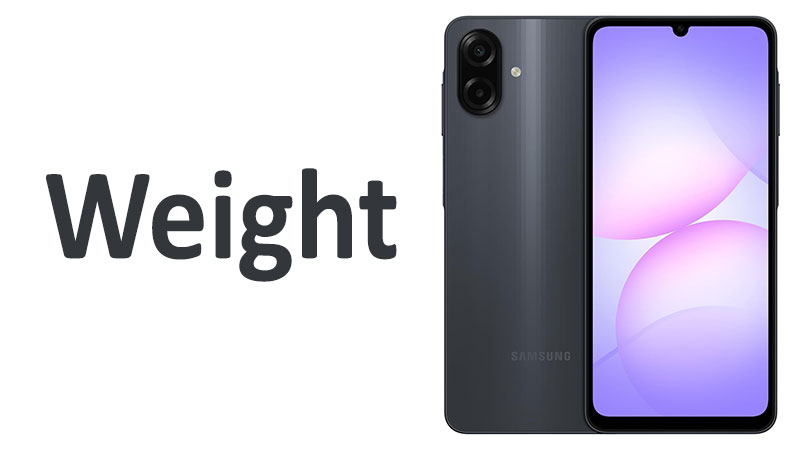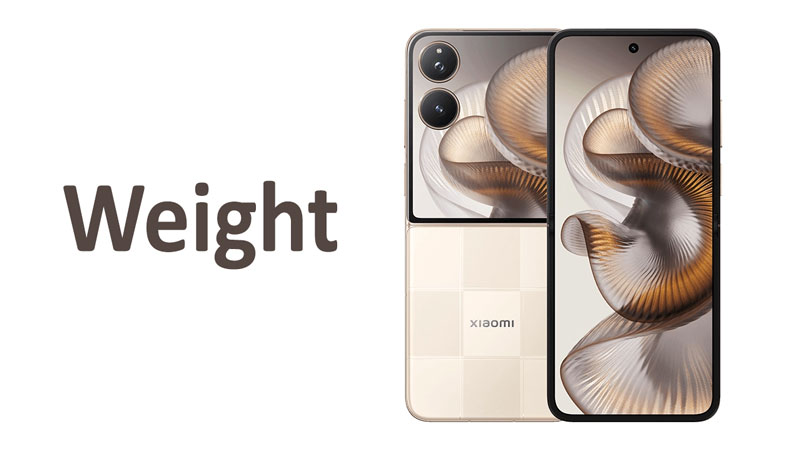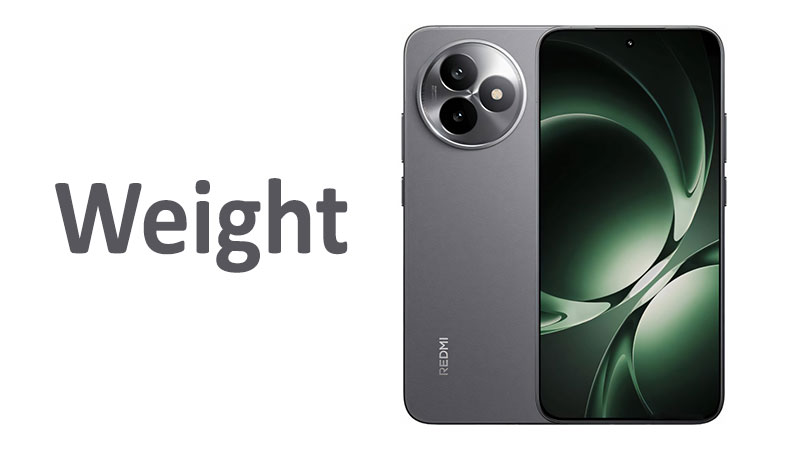The Samsung Galaxy A07 4G weight is a critical specification for potential buyers. It plays a significant role in the overall user experience. This detail determines how comfortable the phone feels during long periods of use. The device registers a mass of 184 grams (g). In imperial units, this converts to 6.49 ounces (oz). This precise weight placement makes the Galaxy A07 4G a notably lightweight option in the competitive budget smartphone segment. Consumers often prioritize screen size and battery life. However, physical mass greatly influences daily handling and portability. We explore how Samsung achieved this weight. We also analyze the impact it has on the phone’s design and usability.
The Significance of the 184g Mass
A smartphone’s weight is more than just a number on a specification sheet. It affects user fatigue, portability, and the perceived quality of the build. The 184g weight of the Samsung Galaxy A07 4G positions it strategically. It feels substantial enough to suggest quality and durability. Yet, it remains light enough to prevent hand strain. This balance is crucial for a large-screen device. The Galaxy A07 4G features a 6.7-inch display. Phones with similar dimensions often approach or exceed the 200-gram mark. Samsung’s engineering choices clearly aimed for user comfort. They focused on delivering a large display experience without the burden of excessive weight.
The Measurement Breakdown: Grams vs. Ounces
Understanding the two primary measurements is helpful for a global audience. The official Samsung Galaxy A07 4G weight is 184 grams. This is the metric standard used internationally. The equivalent imperial measurement is 6.49 ounces. A gram is a small unit of mass. This measure allows for precision in manufacturing specifications. An ounce is a larger unit. It gives North American consumers an immediate reference point. For context, 6.49 ounces is roughly equivalent to the weight of an average baseball. This comparison helps users visualize the phone’s physical presence. This lightweight nature is a strong selling point for the device.
Ergonomics and Daily Use
Weight directly impacts the phone’s ergonomics. The combination of 184g and a slim 7.6 mm profile enhances handling. Users often hold their smartphones for hours each day. These activities include scrolling through social media, watching videos, or engaging in mobile gaming. A heavier phone leads to quicker fatigue in the hand and wrist. The reduced mass of the Galaxy A07 4G minimizes this strain. This makes extended sessions more comfortable. The phone slips easily into pockets or small bags. Its relative lightness contributes significantly to its portability. This design philosophy maximizes user convenience for the target audience.
Analyzing the Physical Dimensions and Build
The final Samsung Galaxy A07 4G weight results from several design and material choices. The phone measures 167.4 x 77.4 x 7.6 mm. The dimensions are large, but the thinness and materials work together. This combination prevents the phone from feeling bulky or dense. The weight management is a direct result of Samsung optimizing the phone’s structural composition. They selected materials that provide necessary rigidity without adding unnecessary bulk.
The Role of Plastic Construction
The materials used in the chassis are the primary factor in achieving the 184g weight. The Galaxy A07 4G uses a glass front, but the back and frame are constructed from plastic. High-end phones typically use metal frames and glass backs. These materials increase both the weight and the cost. By choosing a plastic back and frame, Samsung significantly reduced the overall mass. This material choice provides a durable shell that resists minor impacts and scratches well. The plastic construction is lightweight and cost-effective. It remains a smart decision for an entry-level smartphone. This choice enables Samsung to pass savings and comfort benefits on to the consumer.
Slim Profile: 7.6 mm Thickness
The physical dimensions of the phone contribute to the perception of weight. The Galaxy A07 4G has a very slim profile at just 7.6 mm thick. This thinness is remarkable, especially considering the internal components. A thin phone inherently feels lighter than a thick one, even if their weights are identical. The narrow depth distributes the 184g mass across a wide, flat area. This distribution improves the feel in hand. A thinner device is easier to grip securely, enhancing the sense of control. This design choice highlights Samsung’s focus on a modern, sleek aesthetic in the A-series.
IP54 Rating and Durability
The Galaxy A07 4G includes an IP54 rating for dust and splash resistance. This protective feature adds a negligible amount of weight. The IP rating requires internal seals and gaskets. These components prevent water and dust ingress. Manufacturers typically incorporate these seals into the existing frame structure. The added layer of protection is highly valuable. It ensures the phone can withstand daily hazards like rain or minor spills. The implementation of IP54 protection without impacting the 184g mass showcases efficient engineering. Users benefit from durability without any weight penalty. This feature is a significant improvement over many unprotected budget rivals.
Key Components Contributing to the 184g Mass
Achieving a low weight like 184g is complex when balancing large components. Modern smartphones must integrate powerful batteries, large screens, and advanced cameras. Each of these elements adds mass. The engineering challenge involves minimizing the weight of supporting structures. This allows the essential components to fit within the target weight.
The 5000mAh Battery Paradox
The most surprising element of the 184g specification is the inclusion of a large 5000mAh battery. The battery is usually the heaviest single component in a smartphone. Batteries of this capacity often contribute significantly to a phone’s mass. However, Samsung used the lighter plastic shell to offset this weight. The large battery capacity provides outstanding endurance. The combination of a 5000mAh power source and the light 184g body is a major selling point. It ensures the phone lasts for a very long time without being cumbersome. Users get the benefit of all-day or even two-day battery life. They do not carry a heavy device. This balance is a primary competitive advantage.
Display Size and Technology
The 6.7-inch PLS LCD display is the second largest component affecting the weight. A large display requires a large glass sheet, which adds mass. Samsung used a PLS LCD panel. This technology generally involves simpler, and often lighter, internal structures compared to complex AMOLED displays. The absence of a thick, heavy protective layer like Gorilla Glass Victus further contributes to weight reduction. However, some sources suggest Gorilla Glass is used. If so, it would likely be an older, lighter generation. The overall display assembly is designed to be as light as possible. This choice supports the 6.7-inch immersive viewing experience. It maintains the desired portability profile.
The Mediatek Helio G99 Chipset and Internal Structure
The internal logic board and chipset also affect the final weight. The Galaxy A07 4G uses the Mediatek Helio G99 processor. This chip is efficient and runs on a 6nm architecture. This efficiency means the phone produces less heat. Less heat requires less extensive and heavy cooling hardware. Flagship phones often need thick vapor chambers or graphite layers. These components add significant weight. The A07 4G avoids these heavy-duty cooling solutions. It relies on its efficient chipset and passive heat dissipation. This streamlined internal structure keeps the mass down to 184g. It contributes to both the slimness and the lightness of the device.
Specialized Weight Comparisons
Understanding the 184g weight requires comparison with other devices in the market. Comparing the Samsung Galaxy A07 4G weight to its predecessor and competitors reveals its market position. The phone’s mass represents an engineering upgrade. It shows an intentional shift towards a lighter, more ergonomic design.
Versus the Predecessor: Galaxy A05
The direct comparison with the Samsung Galaxy A05 is highly revealing. The Samsung Galaxy A05 weighed 195 grams. The Galaxy A07 4G weighs 184 grams. This represents a weight reduction of 11 grams. An 11g difference may seem small. However, it translates to a noticeable change in hand. Manufacturers rarely achieve significant weight loss while increasing performance and maintaining battery size. The A07 4G manages to be lighter, thinner (7.6 mm vs 8.8 mm on the A05), and features a more powerful Mediatek Helio G99 chip. It also adds an IP54 rating, which typically adds weight. This reduction demonstrates highly efficient component layout and material sourcing. The Galaxy A07 4G is objectively superior in terms of build and feel.
Comparison with Samsung A-Series Siblings
Within the broader Samsung A-series, the Galaxy A07 4G weight is impressive. Mid-range Samsung models, like the Galaxy A17, often weigh more. They incorporate slightly more premium materials or larger feature sets. Many other A-series models hover around 190 to 200 grams. For example, some devices with similar screen sizes easily exceed 195g. The A07 4G maintains its weight advantage despite its large 6.7-inch screen. It provides a lightweight alternative for users prioritizing comfort. It sacrifices higher-end materials for better long-term handling comfort. This makes it an ideal choice for consumers moving from smaller, older devices. It offers a bigger screen without the proportional increase in heft.
Competitive Landscape Weight Analysis
The budget and entry-level segment is highly competitive. Many rivals from brands like Honor, Tecno, and Xiaomi offer similar specifications. However, the Samsung Galaxy A07 4G weight often gives it an edge in portability. Competitors frequently exceed the 190g threshold for a 5000mAh battery device. For instance, some comparable models with similar specs weigh 187g or even 195g. The A07 4G consistently sits near the lighter end of the scale for this size and battery class. This characteristic is particularly appealing in markets where users carry their phones constantly. The 184g figure helps the Galaxy A07 4G stand out as a thoughtfully designed, lightweight smartphone. It delivers powerful battery life in a manageable package.
Pros, Cons, and Buyer Considerations
The 184g weight of the Samsung Galaxy A07 4G generates both advantages and some minor trade-offs. Buyers must weigh these factors when making a purchase decision. The weight is intrinsically linked to the phone’s materials and overall design philosophy.
Advantages of the A07’s Low Weight
The primary advantage is user comfort. The lightweight nature reduces strain during extended use. It makes the phone easy to carry in a pocket or handbag. The 184g mass, coupled with the slim 7.6 mm profile, creates a device that feels agile and modern. This lightness also helps mitigate damage from drops. A lighter object hits the ground with less force. This may potentially reduce the severity of impacts. The reduced weight is a direct benefit for commuters and students. They carry the device throughout the day. The phone feels less intrusive and burdensome in daily life.
Potential Drawbacks
Weight reduction in a budget device often involves material compromises. The 184g weight is achieved primarily through the use of a plastic build for the frame and back. While plastic is durable, it lacks the premium feel of glass and metal. Some users associate a heavier weight with better build quality or a more flagship experience. The A07 4G may feel less premium to users accustomed to heavier, higher-end devices. The plastic construction is more susceptible to scratching than Gorilla Glass backs. Potential buyers must accept the lightweight benefit. They must also acknowledge the non-premium material feel. This trade-off is common and acceptable in the entry-level market.
Important Points a Buyer Should Know
Buyers interested in the Samsung Galaxy A07 4G should understand the context of the 184g weight. The low mass is a feature, not a flaw. It is a deliberate design choice that prioritizes usability and battery capacity. This lightweight design is particularly beneficial for its impressive 5000mAh battery life. The phone offers excellent power endurance without the typical heavy feel. They should also note the phone is large. The 6.7-inch screen means the physical dimensions are considerable (167.4 x 77.4 mm). The low weight prevents the large footprint from feeling overwhelming. Overall, the Galaxy A07 4G is a powerful, durable, and highly portable budget smartphone. Its weight makes it a strong contender in its class.
Detailed Review of Other Features
While weight is the focus, the other specifications support the A07 4G’s value proposition. The phone pairs its ergonomic design with robust hardware. This ensures a smooth and reliable user experience.
Performance and Chipset Efficiency
The phone uses the Mediatek Helio G99 chipset. This is a significant upgrade from its predecessor. The G99 is built on a 6nm process. This technology is highly power-efficient. It delivers solid performance for daily tasks and moderate gaming. The efficient chipset complements the 5000mAh battery. It extends the time between charges dramatically. The phone offers up to 8GB of RAM in higher configurations. This ample memory ensures smooth multitasking. Users can switch between apps without noticeable lag. The performance is robust for its price point.
The 6.7-inch 90Hz Display
The display technology contributes to both the visual experience and the weight. The 6.7-inch PLS LCD panel offers a large viewing area. It has an HD+ resolution (720 x 1600 pixels). The resolution is standard for this class. The key upgrade is the 90Hz refresh rate. This higher refresh rate makes scrolling and animations appear much smoother. This smoothness enhances the user experience significantly. While the color vibrancy may not match AMOLED, the 90Hz refresh rate is a notable feature in this budget category. The large size makes it ideal for media consumption.
Camera System Capabilities
The Galaxy A07 4G features a dual-camera setup. It has a 50-megapixel primary sensor. This high-resolution sensor captures detailed images in good lighting conditions. The second camera is a 2-megapixel depth sensor. This sensor assists with portrait mode photos. It accurately blurs the background. The front camera is an 8-megapixel sensor. This is adequate for selfies and video calls. The camera system is dependable for everyday photography. It offers strong performance for a budget device. Users find the 50MP sensor provides flexibility for cropping and editing.
Software Commitment and Longevity
Samsung offers a class-leading software commitment for the Galaxy A07 4G. It promises up to six major Android OS upgrades. It also guarantees six years of security updates. This is exceptionally long-term support for a budget phone. This extended support enhances the phone’s value proposition immensely. The phone remains current and secure for years. This commitment is a powerful reason to choose the A07 4G over competitors. Longevity means users do not need to replace the device as frequently.
Conclusion
The Samsung Galaxy A07 4G weight, standing at 184 grams (6.49 ounces), is one of its most compelling attributes. This specification is not merely a technical detail. It represents a successful design choice. Samsung delivered a large 6.7-inch display and a massive 5000mAh battery. They achieved this while maintaining a slim and highly portable profile. The use of plastic construction is a necessary trade-off. It enabled the impressive weight management. This decision enhances long-term comfort and handling. The A07 4G is lighter and thinner than its predecessor, the A05. It features significant upgrades like the Helio G99 chipset and a 90Hz display. For the budget-conscious buyer, the A07 4G offers an excellent balance. It provides powerful battery life, a modern screen experience, and class-leading software support. Its lightweight design ensures that power and size do not come at the expense of ergonomic comfort. The 184g Galaxy A07 4G is a smart choice for extended, fatigue-free usage.
Frequently Asked Questions (FAQ)
Is the Samsung Galaxy A07 4G considered a lightweight smartphone?
Yes, the Samsung Galaxy A07 4G is considered lightweight for its size. It weighs 184 grams. This is notably light for a phone featuring a large 6.7-inch display and a 5000mAh battery.
How much does the Galaxy A07 4G weigh in ounces?
The Samsung Galaxy A07 4G weighs 6.49 ounces. This measurement is the imperial equivalent of its official mass of 184 grams.
What contributes to the low 184g weight of the Galaxy A07 4G?
The primary contributor to the low weight is the build material. The phone uses a plastic back and plastic frame. This material is significantly lighter than the glass or metal used in more expensive devices.
Does the 5000mAh battery make the Galaxy A07 4G heavy?
No, the 5000mAh battery does not make the A07 4G heavy. Samsung effectively balanced the battery’s weight with lighter body materials. This results in an overall mass of only 184g, which is light for a phone with this battery capacity.
Is the Galaxy A07 4G lighter than its previous model, the Galaxy A05?
Yes, the Galaxy A07 4G is lighter than its predecessor. The Galaxy A07 4G weighs 184g. The older Galaxy A05 weighed 195g. This represents a reduction of 11 grams.



